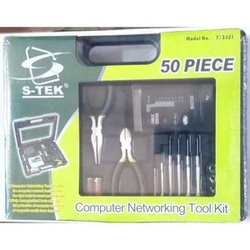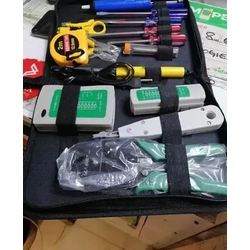
Networking Cable Wire Tracer/Tracker
A networking cable wire tracer/tracker is a device used to locate and identify network cables within a complex cabling infrastructure. It is a valuable tool for network technicians and IT professionals who need to troubleshoot, maintain, or upgrade network systems.
- Cable Identification: The tracer helps identify a specific cable among a bundle or a network cabinet filled with numerous cables. This capability saves time and prevents the need for manual cable tracing or guessing.
- Signal Detection: The receiver detects the transmitted signal or tone emitted by the transmitter. It can pick up the signal through insulation, walls, and other obstacles, allowing the technician to trace the cable's path even if it is hidden or buried.
- Visual and Audible Indicators: The receiver usually has visual indicators such as LED lights and an LCD screen, along with audible alerts like beeps or tones, to guide the technician towards the cable being traced. These indicators intensify as the receiver gets closer to the target cable.
- Cable Testing: Many wire tracers come with additional cable testing capabilities. They can verify cable continuity, check for breaks or short circuits, measure cable length, and identify crossed or miswired connections.
| SKU | 1289 |
|---|
Reviews
This product does not have any reviews yet.
Add your reviewDescription
A networking cable wire tracer/tracker is a device used to locate and identify network cables within a complex cabling infrastructure. It is a valuable tool for network technicians and IT professionals who need to troubleshoot, maintain, or upgrade network systems.
The wire tracer consists of two main components: a transmitter and a receiver. The transmitter is connected to one end of the network cable, typically at the network switch or patch panel, and emits a signal or tone onto the cable. The receiver, equipped with a probe or sensor, is used to detect and locate the signal along the cable's path.
Key features and functionalities of a typical networking cable wire tracer/tracker:
-
Cable Identification: The tracer helps identify a specific cable among a bundle or a network cabinet filled with numerous cables. This capability saves time and prevents the need for manual cable tracing or guessing.
-
Signal Detection: The receiver detects the transmitted signal or tone emitted by the transmitter. It can pick up the signal through insulation, walls, and other obstacles, allowing the technician to trace the cable's path even if it is hidden or buried.
-
Visual and Audible Indicators: The receiver usually has visual indicators such as LED lights and an LCD screen, along with audible alerts like beeps or tones, to guide the technician towards the cable being traced. These indicators intensify as the receiver gets closer to the target cable.
-
Cable Testing: Many wire tracers come with additional cable testing capabilities. They can verify cable continuity, check for breaks or short circuits, measure cable length, and identify crossed or miswired connections.
-
Multiple Tracing Modes: Tracers often offer different tracing modes to adapt to various network environments. For example, they may have both analog and digital tracing modes, which work with different types of cables (e.g., coaxial, twisted-pair, or fiber optic).
-
Portability and Ergonomics: Wire tracers are designed to be portable and easy to handle. They are typically compact, lightweight, and feature ergonomic grips or handles for comfortable use over extended periods.
-
Accessories: Additional accessories such as adapters, alligator clips, and remote identifiers may be included with the wire tracer to enhance its versatility and compatibility with different cable types and connectors.
-
Safety Features: Tracers often include safety mechanisms to protect the technician and the network equipment. For example, they may have built-in voltage detection to alert users if there is an active electrical current on the cable.
Overall, a networking cable wire tracer/tracker simplifies the process of identifying and tracing network cables, enabling efficient troubleshooting, maintenance, and management of complex network infrastructures.



